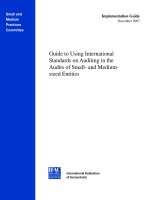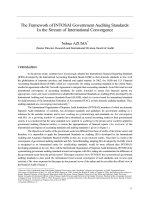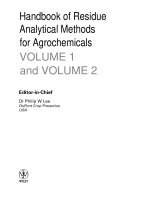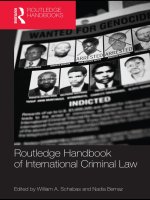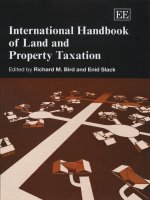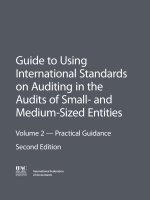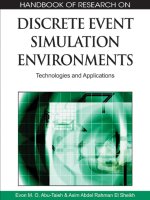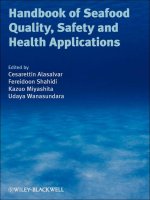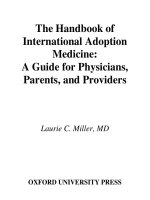handbook of international quality control, auditing review, other assurance, and related services pronouncements
Bạn đang xem bản rút gọn của tài liệu. Xem và tải ngay bản đầy đủ của tài liệu tại đây (6.35 MB, 961 trang )
International Auditing and
Assurance Standards Board
Handbook of International
Quality Control, Auditing
Review, Other Assurance,
and Related Services
Pronouncements
2012 Edition
Volume I
International Federation of Accountants
529 Fifth Avenue, 6th Floor
New York, New York 10017 USA
This publication was published by the International Federation of Accountants (IFAC). Its mission is to
serve the public interest, strengthen the worldwide accountancy profession and contribute to the
development of strong international economies by establishing and promoting adherence to high
quality professional standards, furthering the international convergence of such standards and
speaking out on public interest issues where the profession’s expertise is most relevant. This
publication may be downloaded free of charge for personal use only from the IAASB website
www.iaasb.org.
International Standards on Auditing, International Standards on Assurance Engagements, International
Standards on Review Engagements, International Standards on Related Services, International
Standards on Quality Control, International Auditing Practice Notes, Exposure Drafts, Consultation
Papers, and other IAASB publications are published by, and copyright of, IFAC.
The IAASB and IFAC do not accept responsibility for loss caused to any person who acts or refrains
from acting in reliance on the material in this publication, whether such loss is caused by negligence or
otherwise.
The IAASB logo, ‘International Auditing and Assurance Standards Board’, ‘IAASB’, ‘International
Standard on Auditing’, ‘ISA’, ‘International Standard on Assurance Engagements’, ‘ISAE’, ‘International
Standards on Review Engagements’, ‘ISRE’, ‘International Standards on Related Services’, ‘ISRS’,
‘International Standards on Quality Control’, ‘ISQC’, ‘International Auditing Practice Note’, ‘IAPN’, the
IFAC logo, ‘International Federation of Accountants’, and ‘IFAC’ are trademarks and service marks of
IFAC.
Copyright © July 2012 by the International Federation of Accountants (IFAC). All rights reserved.
Permission is granted to make copies of this work provided that such copies are for use in academic
classrooms or for personal use and are not sold or disseminated and provided that each copy bears
the following credit line: “Copyright © July 2012 by the International Federation of Accountants
(IFAC). All rights reserved. Used with permission of IFAC. Contact for
permission to reproduce, store or transmit this document.” Otherwise, written permission from IFAC is
required to reproduce, store, transmit, or make other similar uses of this document, except as
permitted by law. Contact
.
ISBN: 978-1-60815-122-6
Published by:
CONTENTS PART I
INTERNATIONAL STANDARDS ON AUDITING AND QUALITY CONTROL PART I
HANDBOOK OF INTERNATIONAL
QUALITY CONTROL, AUDITING, REVIEW, OTHER
ASSURANCE, AND RELATED SERVICES
PRONOUNCEMENTS
PART I
CONTENTS
Page
Changes of Substance from the 2010 Edition of the Handbook and Recent
Developments 1–3
The International Federation of Accountants 4–7
Structure of Pronouncements Issued by the International Auditing and
Assurance Standards Board 8
Preface to the International Quality Control, Auditing, Review, Other
Assurance, and Related Services Pronouncements 9–13
Glossary of Terms 14–36
INTERNATIONAL STANDARDS ON QUALITY CONTROL (ISQCs)
International Standard on Quality Control (ISQC) 1, Quality Control for
Firms that Perform Audits and Reviews of Financial Statements,
and Other Assurance and Related Services Engagements 37–71
AUDITS OF HISTORICAL FINANCIAL INFORMATION
200–299
GENERAL PRINCIPLES AND RESPONSIBILITIES
ISA 200, Overall Objectives of the Independent Auditor and the Conduct
of an Audit in Accordance with International Standards on Auditing 72–100
ISA 210, Agreeing the Terms of Audit Engagements 101–123
ISA 220, Quality Control for an Audit of Financial Statements 124–142
ISA 230, Audit Documentation 143–155
ISA 240, The Auditor’s Responsibilities Relating to Fraud in an Audit
of Financial Statements 156–198
ISA 250, Consideration of Laws and Regulations in an Audit of
Financial Statements 199–213
ISA 260, Communication with Those Charged with Governance 214–238
ISA 265, Communicating Deficiencies in Internal Control to Those
Charged with Governance and Management 239–250
HANDBOOK OF INTERNATIONAL QUALITY CONTROL, AUDITING, REVIEW,
OTHER ASSURANCE, AND RELATED SERVICES PRONOUNCEMENTS
PART I
CONTENTS PART I
300–499 RISK ASSESSMENT AND RESPONSE TO ASSESSED RISKS
ISA 300, Planning an Audit of Financial Statements 251–264
ISA 315, Identifying and Assessing the Risks of Material Misstatement
through Understanding the Entity and Its Environment 265–314
ISA 320, Materiality in Planning and Performing an Audit 315–323
ISA 330, The Auditor’s Responses to Assessed Risks 324–346
ISA 402, Audit Considerations Relating to an Entity Using a Service
Organization 347–369
ISA 450, Evaluation of Misstatements Identified during the Audit 370–381
500–599
AUDIT EVIDENCE
ISA 500, Audit Evidence 382–398
ISA 501, Audit Evidence—Specific Considerations for Selected Items 399–409
ISA 505, External Confirmations 410–421
ISA 510, Initial Audit Engagements—Opening Balances 422–434
ISA 520, Analytical Procedures 435–442
ISA 530, Audit Sampling 443–459
ISA 540, Auditing Accounting Estimates, Including Fair Value
Accounting Estimates, and Related Disclosures 460–504
ISA 550, Related Parties 505–531
ISA 560, Subsequent Events 532–544
ISA 570, Going Concern 545–561
ISA 580, Written Representations 562–578
600–699
USING THE WORK OF OTHERS
ISA 600, Special Considerations—Audits of Group Financial Statements
(Including the Work of Component Auditors) 579–626
ISA 610, Using the Work of Internal Auditors 628–634
ISA 620, Using the Work of an Auditor’s Expert 635–655
700–799
AUDIT CONCLUSIONS AND REPORTING
ISA 700, Forming an Opinion and Reporting on Financial Statements 656–684
ISA 705, Modifications to the Opinion in the Independent Auditor’s Report 685–712
ISA 706, Emphasis of Matter Paragraphs and Other Matter Paragraphs
in the Independent Auditor’s Report 713–723
HANDBOOK OF INTERNATIONAL QUALITY CONTROL, AUDITING, REVIEW,
OTHER ASSURANCE, AND RELATED SERVICES PRONOUNCEMENTS
PART I
CONTENTS PART I
INTERNATIONAL STANDARDS ON AUDITING AND QUALITY CONTROL PART I
ISA 710, Comparative Information—Corresponding Figures and
Comparative Financial Statements 724–742
ISA 720, The Auditor’s Responsibilities Relating to Other Information in
Documents Containing Audited Financial Statements 743–748
800–899
SPECIALIZED AREAS
ISA 800, Special Considerations—Audits of Financial Statements
Prepared in Accordance with Special Purpose Frameworks 749–764
ISA 805, Special Considerations—Audits of Single Financial Statements
and Specific Elements, Accounts or Items of a Financial Statement 765–783
ISA 810, Engagements to Report on Summary Financial Statements 784–809
I
NTERNATIONAL AUDITING PRACTICE NOTES
IAPN 1000, Special Considerations in Auditing Financial Instruments 810–876
R
EVISED STANDARDS NOT YET EFFECTIVE
ISA 315 (Revised), Identifying and Assessing the Risks of Material
Misstatement through Understanding the Entity and Its Environment 877–930
ISA 610 (Revised), Using the Work of Internal Auditors 931–947
Conforming Amendments to Other ISAs 948–955
THIS PAGE INTENTIONALLY LEFT BLANK
CHANGES
1
CHANGES
CHANGES OF SUBSTANCE FROM THE 2010 EDITION OF
THE HANDBOOK AND RECENT DEVELOPMENTS
References
This handbook contains references to International Accounting Standards (IASs) and
International Financial Reporting Standards (IFRSs). Unless otherwise indicated,
references to IASs and IFRSs are to the IASs and IFRSs in effect at the date of
preparing a pronouncement. Accordingly, readers are cautioned that, where a revised
IAS or IFRS has been issued subsequently, reference should be made to the most
recent IAS or IFRS.
References to “country” in this handbook should be read as “country or jurisdiction.”
Pronouncements Issued by the International Auditing and
Assurance Standards Board
This handbook contains the complete set of International Auditing and Assurance
Standards Board’s (IAASB) pronouncements on quality control, auditing, review,
other assurance and related services, a glossary of terms, and a preface to the
international standards, as well as the non-authoritative International Auditing
Practice Notes (IAPNs). This handbook replaces the 2009 edition of the Handbook.
Additions
IAPN 1000 and Changes to the Preface
Part I of the handbook includes the International Auditing Practice Note (IAPN)
1000, Special Considerations in Auditing Financial Instruments, issued by the
IAASB in December 2011. IAPN 1000 provides important practical assistance to
auditors when addressing valuation and other considerations pertaining to financial
instruments. It is non-authoritative and is organized in two sections to provide (i)
background and educational material on financial instruments to assist auditors in
understanding them, and (ii) relevant audit considerations, in particular in relation to
valuation of financial instruments. Although IAPN 1000 focuses primarily on the
needs of auditors who have less frequent contact with financial instruments, it is
relevant to audits of entities of all sizes, as all entities may be subject to risks of
material misstatement when using financial instruments. IAPN 1000 is currently
effective.
In finalizing IAPN 1000, the IAASB evaluated the clarity and appropriateness of the
authority of the existing International Auditing Practice Statements (IAPSs.) The
IAASB decided to withdraw the existing category of pronouncements known as
IAPSs and to establish IAPNs, as reflected in the amended Preface to the
International Quality Control, Auditing, Review, Other Assurance, and Related
Services Pronouncements. Part I of the handbook contains the amended Preface.
CHANGES OF SUBSTANCE FROM THE 2010 EDITION OF
THE HANDBOOK AND RECENT DEVELOPMENTS
CHANGES
2
ISA 610 (Revised), ISA 315 (Revised) and Conforming Amendments to Other ISAs
Part I of the handbook includes the International Standard on Auditing (ISA) 610
(Revised), Using the Work of Internal Auditors, issued by the IAASB in March
2012. This revised standard deals with the external auditor’s responsibilities if using
the work of an internal audit function in obtaining audit evidence. Related changes
have also been made to ISA 315 (Revised), Identifying and Assessing the Risks of
Material Misstatement through Understanding the Entity and Its Environment, to
explain how the internal audit function and its findings can usefully inform the
external auditor’s risk assessments. Conforming amendments to other ISAs as a
result of these revisions were also made.
In revising ISA 610, the IAASB also agreed on requirements and guidance that
specify the conditions and establish responsibilities of the external auditor if the
external auditor intends to use internal auditors to provide direct assistance during
the audit. The IAASB has engaged closely with the IESBA in relation to this matter.
While the IAASB has concluded its deliberations on the requirements addressing
direct assistance, it intends to incorporate such material in ISA 610 (Revised) only
after the IESBA concludes its deliberations on its February 2012 exposure draft of
proposed changes to the definition of “engagement team” in the Code of Ethics for
Professional Accountants (IESBA Code). The IESBA exposure draft proposes to
resolve a perceived inconsistency between the ISAs and the IESBA Code regarding
the ability of external auditors to use internal auditors to provide direct assistance.
When the IAASB finalizes the material on direct assistance, it will also consider
whether further minor conforming amendments are necessary to its other
international standards in light of the material in ISA 610 (Revised).
ISA 610 (Revised), ISA 315 (Revised), and the conforming amendments to other
ISAs are effective for audits of financial statements for periods ending on or after
December 15, 2013, at which time ISA 610 and ISA 315 will be withdrawn.
ISAE 3410
Part II of the handbook includes the International Standard on Assurance
Engagements (ISAE) 3420, Assurance Engagements on Greenhouse Gas Statements,
issued by the IAASB in June 2012. This new standard deals with both limited
assurance and reasonable assurance engagements undertaken by a practitioner to
report on an entity’s greenhouse gas statement. The ISAE can be applied to
greenhouse gas statements prepared, for example, as part of a regulatory disclosure
regime, as part of an emissions trading scheme, or to inform investors and others on
a voluntary basis.
ISAE 3410 is effective for assurance reports covering periods ending on or after
September 30, 2013.
CHANGES OF SUBSTANCE FROM THE 2010 EDITION OF
THE HANDBOOK AND RECENT DEVELOPMENTS
CHANGES
3
CHANGES
ISAE 3420
Part II of the handbook includes the International Standard on Assurance
Engagements (ISAE) 3420, Assurance Engagements to Report on the Compilation of
Pro Forma Financial Information Included in a Prospectus, issued by the IAASB in
December 2011. This new standard deals with reasonable assurance engagements
undertaken by a practitioner to report on the responsible party’s compilation of pro
forma financial information included in a prospectus. The ISAE applies where such
reporting is required by securities law or the regulation of the securities exchange in
the jurisdiction in which the prospectus is to be issued, or this reporting is generally
accepted practice in such jurisdiction.
ISAE 3420 is effective for assurance reports dated on or after March 31, 2013.
ISRS 4410 (Revised)
Part II of the handbook includes the International Standard on Related Services
(ISRS) 4410 (Revised), Compilation Engagements, issued by the IAASB in March
2012. A revision of ISRS 4410, Engagements to Compile Financial Information, this
revised standard deals with the practitioner’s responsibilities when engaged to assist
management with the preparation and presentation of historical financial information
without obtaining any assurance on that information, and to report on the
engagement in accordance with this ISRS.
ISRS 4410 (Revised) is effective for compilation engagement reports dated on or
after July 1, 2013, at which time ISRS 4410 will be withdrawn.
Withdrawals
When the category of IAPSs was withdrawn, the six existing IAPSs contained in Part
II of the 2010 edition of the handbook were also withdrawn as the IAASB
determined that they were largely outdated and inconsistent with the text of the
clarified ISAs.
Final Pronouncements Issued Subsequent to June 30, 2012 and Exposure Drafts
For information on recent developments and to obtain final pronouncements issued
subsequent to June 30, 2012 or outstanding exposure drafts, visit the IAASB’s
website at www.iaasb.org
.
IFAC BACKGROUND
4
THE INTERNATIONAL FEDERATION OF ACCOUNTANTS
The Organization
The International Federation of Accountants (IFAC) is the worldwide organization
for the accountancy profession. Founded in 1977, its mission is to serve the public
interest by: contributing to the development, adoption and implementation of high-
quality international standards and guidance; contributing to the development of
strong professional accountancy organizations and accounting firms, and to high-
quality practices by professional accountants; promoting the value of professional
accountants worldwide; speaking out on public interest issues where the accountancy
profession’s expertise is most relevant.
IFAC is comprised of 167 members and associates in 127 countries worldwide,
representing approximately 2.5 million accountants in public practice, industry and
commerce, the public sector, and education. No other accountancy body in the world
and few other professional organizations have the broad-based international support
that characterizes IFAC.
IFAC’s governing bodies, staff, and volunteers are committed to the values of
integrity, transparency and expertise. IFAC also seeks to reinforce professional
accountants’ adherence to these values through the International Ethics Standards
Board for Accountants’ Code of Ethics for Professional Accountants (IESBA Code).
Visit the IFAC website at www.ifac.org
for further information.
Standard-Setting Initiatives
IFAC has long recognized that a fundamental way to protect the public interest is to
develop, promote, and enforce internationally recognized standards as a means of
ensuring the credibility of information upon which investors and other stakeholders
depend.
As such, IFAC provides the structures and processes that support the operations of
four independent standard-setting boards: the International Auditing and Assurance
Standards Board (IAASB), the International Accounting Education Standards Board
(IAESB), the International Ethics Standards Board for Accountants (IESBA), and the
International Public Sector Accounting Standards Board (IPSASB). These
independent standard-setting boards follow a rigorous due process that supports the
development of high-quality standards in the public interest in a transparent,
efficient, and effective manner; in addition, all have Consultative Advisory Groups
that provide public interest perspectives, and include public members. These boards
issue the following pronouncements:
• Code of Ethics for Professional Accountants
• International Standards on Auditing, Review, Other Assurance, and Related
Services
• International Standard on Quality Control
BACKGROUND INFORMATION ON IFAC AND OTHER RESOURCES
IFAC BACKGROUND
5
IFAC
• International Education Standards
• International Public Sector Accounting Standards
The IAASB, IAESB and IESBA are subject to oversight by the Public Interest
Oversight Board. See www.ipiob.org
for more information.
The Compliance Advisory Panel (CAP) oversees IFAC’s member body compliance
program, which requires IFAC members and associates to demonstrate how they
have used best endeavors to implement the standards issued by IFAC and the
International Accounting Standards Board. Member bodies’ obligations are set out in
IFAC’s Statements of Membership Obligations. See
www.ifac.org/complianceprogram
for more information.
Other Initiatives
IFAC develops benchmark guidance and promotes the sharing of resources to serve
professional accountants in business. It has also established groups to address issues
pertaining to small and medium practices (SMPs) and entities (SMEs) and
developing nations, all of which play a critical role in the global economy.
• Professional Accountants in Business Committee
The Professional Accountants in Business (PAIB) Committee serves IFAC
member bodies and professional accountants worldwide who work in
commerce, industry, financial services, education, and the public and not-for-
profit sectors. Its objectives are to promote and contribute to the value of
professional accountants in business by increasing awareness of the important
roles professional accountants play in creating, enabling, preserving, and
reporting value for organizations and their stakeholders; and to support
member bodies in enhancing the competence of their members to fulfill those
roles. These objectives are achieved by facilitating the communication and
sharing of good practices and ideas. See www.ifac.org/paib
for more
information.
• Small and Medium Practices Committee
The committee provides direct input from an SMP/SME perspective into the
work of international standard setters to shape their work agenda and ensure
standards produced are relevant and proportional to SMPs and SMEs. The
committee also issues practical support for SMPs such as implementation
guides and web-based resources on topics such as efficient implementation of
international standards and proficient practice management. The committee
engages in outreach activities such as the annual SMP Forum, to keep abreast
of emerging issues, raise awareness of the importance and value of this sector,
and facilitate timely response to its constituents’ needs. See
www.ifac.org/smp
for more information.
BACKGROUND INFORMATION ON IFAC AND OTHER INFORMATION
IFAC BACKGROUND
6
• Professional Accountancy Organization Development Committee
The committee’s focus is on addressing the challenges facing the development
of strong professional accountancy organizations (PAOs) in emerging and
developing countries. It brings together individuals from both developed and
developing nations, who drive an agenda to raise awareness of accountancy,
bring attention to the need for a formal profession, and highlight the economic
and social benefits that a formal profession can bring. See
www.ifac.org/about-ifac/professional-accountancy-organization-
development-committee for more information.
• Transnational Auditors Committee
The committee operates as the executive arm of the Forum of Firms (FoF,
Forum), an association of international networks of accounting firms that
perform transnational audits. It provides the official linkage between the
Forum and IFAC and plays a major role in encouraging members of the
Forum to meet high-quality standards in the practice of international auditing.
See www.ifac.org/about-ifac/transnational-auditors-committee
for more
information.
Other Resources
IFAC publishes a wide range of publications and resource materials. Available
handbooks are as follows:
• Handbook of International Quality Control, Auditing, Review, Other
Assurance, and Related Services Pronouncements
• Handbook of International Education Pronouncements
• Handbook of the Code of Ethics for Professional Accountants
• Handbook of International Public Sector Accounting Pronouncements
IFAC also publishes adoption and implementation support materials, exposure drafts,
consultation papers, and print and electronic newsletters. The majority of these
publications are made available in electronic format on the IFAC website for
download free of charge. Printed copies of the handbooks are also available for
purchase. See www.ifac.org/publications-resources
for more information.
Copyright and Translation
IFAC’s policy with regard to copyright of its publications is outlined in its Policy
Statement, Policy for Reproducing, or Translating and Reproducing, Publications
Issued by the International Federation of Accountants.
IFAC recognizes that it is important that preparers and users of financial statements,
auditors, regulators, lawyers, academia, students, and other interested groups in non-
English speaking countries have access to its standards in their native language.
BACKGROUND INFORMATION ON IFAC AND OTHER RESOURCES
IFAC BACKGROUND
7
IFAC
IFAC’s policy with regard to translation and reproduction of its international
standards (in final form) is outlined in its Policy Statement, Policy for Translating
and Reproducing Standards Issued by the International Federation of Accountants.
See www.ifac.org/translations
for more information.
STRUCTURE
8
IESBA Code of Ethics for Professional Accountants
Assurance Engagements Other than
Audits or Reviews of Historical Financial
Information
ISQCs 1–99 International Standards on Quality Control
Audits and Reviews of Historical
Financial Information
International Framework for Assurance Engagements
ISAs 100–999
International Standards
on Auditing
ISAEs 3000–3699
International Standards on Assurance
Engagements
ISREs 2000–2699
International Standards
on Review Engagements
ISRSs 4000–4699
International Standards on Related
Services
Related Services
Services Covered by IAASB Pronouncements
STRUCTURE OF PRONOUNCEMENTS
ISSUED BY THE INTERNATIONAL AUDITING
AND ASSURANCE STANDARDS BOARD
PREFACE
9
PREFACE
PREFACE TO THE INTERNATIONAL QUALITY CONTROL,
AUDITING, REVIEW, OTHER ASSURANCE, AND RELATED
SERVICES PRONOUNCEMENTS
(Effective as of December 15, 2011)
CONTENTS
Paragraph
Introduction 1–2
The IAASB’s Pronouncements 3–4
IAASB Authoritative Pronouncements 3–4
The Authority Attaching to International Standards Issued by the
International Auditing and Assurance Standards Board 5–17
International Standards on Auditing 11
International Standards on Quality Control 12
Other International Standards 13–16
Professional Judgment 17
Applicability of the International Standards 18–19
Non-Authoritative Material 20–22
International Auditing Practice Notes 21–22
Practice Notes Relating to Other International Standards 23
Staff Publications 24
Language 25
PREFACE TO THE INTERNATIONAL QUALITY CONTROL, AUDITING, REVIEW, OTHER
ASSURANCE, AND RELATED SERVICES PRONOUNCEMENTS
PREFACE
10
Introduction
1. This preface to the International Quality Control, Auditing, Review, Other
Assurance, and Related Services Pronouncements is issued to facilitate
understanding of the scope and authority of the pronouncements the
International Auditing and Assurance Standards Board (IAASB) issues, as set
forth in the IAASB’s Terms of Reference.
2. The IAASB is committed to the goal of developing a set of International
Standards and other pronouncements which are generally accepted worldwide.
IAASB members act in the common interest of the public at large and the
worldwide accountancy profession. This could result in their taking a position
on a matter that is not in accordance with current practice in their country or
firm or not in accordance with the position taken by those who put them
forward for membership of the IAASB.
The IAASB’s Pronouncements
IAASB Authoritative Pronouncements
3. The IAASB’s pronouncements govern audit, review, other assurance, and
related services engagements that are conducted in accordance with
International Standards. They do not override the local laws or regulations that
govern the audit of historical financial statements or assurance engagements on
other information in a particular country required to be followed in accordance
with that country’s national standards. In the event that local laws or regulations
differ from, or conflict with, the IAASB’s Standards on a particular subject, an
engagement conducted in accordance with local laws or regulations will not
automatically comply with the IAASB’s Standards. A professional accountant
should not represent compliance with the IAASB’s Standards unless the
professional accountant has complied fully with all standards relevant to the
engagement.
4. The authoritative pronouncements of the IAASB are the International
Standards, which are issued following the IAASB’s stated due process.
The Authority Attaching to International Standards Issued by the
International Auditing and Assurance Standards Board
5. International Standards on Auditing (ISAs) are to be applied in the audit of
historical financial information.
6. International Standards on Review Engagements (ISREs) are to be applied in
the review of historical financial information.
7. International Standards on Assurance Engagements (ISAEs) are to be applied in
assurance engagements other than audits or reviews of historical financial
information.
PREFACE TO THE INTERNATIONAL QUALITY CONTROL, AUDITING, REVIEW, OTHER
ASSURANCE, AND RELATED SERVICES PRONOUNCEMENTS
PREFACE
11
PREFACE
8. International Standards on Related Services (ISRSs) are to be applied to
compilation engagements, engagements to apply agreed upon procedures to
information and other related services engagements as specified by the IAASB.
9. ISAs, ISREs, ISAEs and ISRSs are collectively referred to as the IAASB’s
Engagement Standards.
10. International Standards on Quality Control (ISQCs) are to be applied for all
services falling under the IAASB’s Engagement Standards.
International Standards on Auditing
11. ISAs are written in the context of an audit of financial statements
1
by an
independent auditor. They are to be adapted as necessary in the circumstances
when applied to audits of other historical financial information. The authority
of ISAs is set out in ISA 200.
2
International Standards on Quality Control
12. ISQCs are written to apply to firms in respect of all their services falling under
the IAASB’s Engagement Standards. The authority of ISQCs is set out in the
introduction to the ISQCs.
Other International Standards
13. Some International Standards identified in paragraphs 6–8 contain: objectives,
requirements, application and other explanatory material, introductory material
and definitions. These terms are to be interpreted in a directly analogous way to
how they are explained in the context of ISAs and financial statement audits in
ISA 200.
14. Other International Standards identified in paragraphs 6–8 contain basic
principles and essential procedures (identified in bold type lettering and by the
word “should”) together with related guidance in the form of explanatory and
other material, including appendices. The basic principles and essential
procedures are to be understood and applied in the context of the explanatory
and other material that provides guidance for their application. It is therefore
necessary to consider the entire text of a Standard to understand and apply the
basic principles and essential procedures.
15. The basic principles and essential procedures of a Standard are to be applied in
all cases where they are relevant in the circumstances of the engagement. In
exceptional circumstances, however, a professional accountant may judge it
1
Unless otherwise stated, “financial statements” mean financial statements comprising historical financial
information.
2
ISA 200, Overall Objectives of the Independent Auditor and the Conduct of an Audit in Accordance with
International Standards on Auditing
PREFACE TO THE INTERNATIONAL QUALITY CONTROL, AUDITING, REVIEW, OTHER
ASSURANCE, AND RELATED SERVICES PRONOUNCEMENTS
PREFACE
12
necessary to depart from a relevant essential procedure in order to achieve the
purpose of that procedure. When such a situation arises, the professional
accountant is required to document how alternative procedures performed
achieve the purpose of the procedure and, unless otherwise clear, the reasons
for the departure. The need for the professional accountant to depart from a
relevant essential procedure is expected to arise only where, in the specific
circumstances of the engagement, that procedure would be ineffective.
16. Appendices, which form part of the application material, are an integral part of
a Standard. The purpose and intended use of an appendix are explained in the
body of the related Standard or within the title and introduction of the appendix
itself.
Professional Judgment
17. The nature of the International Standards requires the professional accountant
to exercise professional judgment in applying them.
Applicability of the International Standards
18. The scope, effective date and any specific limitation of the applicability of a
specific International Standard is made clear in the Standard. Unless otherwise
stated in the International Standard, the professional accountant is permitted to
apply an International Standard before the effective date specified therein.
19. International Standards are relevant to engagements in the public sector. When
appropriate, additional considerations specific to public sector entities are
included:
(a) Within the body of an International Standard in the case of ISAs and
ISQCs; or
(b) In a Public Sector Perspective (PSP) appearing at the end of other
International Standards.
Non-Authoritative Material
20. Non-authoritative material includes Practice Notes issued by the IAASB and
staff publications. Non-authoritative material is not part of the IAASB’s
International Standards.
PREFACE TO THE INTERNATIONAL QUALITY CONTROL, AUDITING, REVIEW, OTHER
ASSURANCE, AND RELATED SERVICES PRONOUNCEMENTS
PREFACE
13
PREFACE
International Auditing Practice Notes
21. International Auditing Practice Notes (IAPNs) do not impose additional
requirements on auditors beyond those included in the ISAs, nor do they
change the auditor’s responsibility to comply with all ISAs relevant to the
audit. IAPNs provide practical assistance to auditors. They are intended to be
disseminated by those responsible for national standards, or used in developing
corresponding national material. They also provide material that firms can use
in developing their training programs and internal guidance.
22. Depending on the nature of the topic(s) covered, an IAPN may assist the
auditor in:
• Obtaining an understanding of the circumstances of the entity, and in
making judgments about the identification and assessment of risks of
material misstatement;
• Making judgments about how to respond to assessed risks, including
judgments about procedures that may be appropriate in the
circumstances; or
• Addressing reporting considerations, including forming an opinion on
the financial statements and communicating with those charged with
governance.
Practice Notes Relating to Other International Standards
23. The IAASB may also issue International Review Engagement Practice Notes
(IREPNs), International Assurance Engagement Practice Notes (IAEPNs), and
International Related Services Practice Notes (IRSPNs) to serve the same
purpose for ISREs, ISAEs, and ISRSs respectively.
Staff Publications
24. Staff publications are used to help raise practitioners’ awareness of significant
new or emerging issues by referring to existing requirements and application
material, or to direct their attention to relevant provisions of IAASB
pronouncements.
Language
25. The sole official text of an IAASB International Standard, Practice Note,
exposure draft or other publication is that published by the IAASB in the
English language.
GLOSSARY
14
GLOSSARY OF TERMS
1
(June 2012)
Access controls—Procedures designed to restrict access to on-line terminal devices,
programs and data. Access controls consist of “user authentication” and “user
authorization.” “User authentication” typically attempts to identify a user through
unique logon identifications, passwords, access cards or biometric data. “User
authorization” consists of access rules to determine the computer resources each user
may access. Specifically, such procedures are designed to prevent or detect:
(a) Unauthorized access to on-line terminal devices, programs and data;
(b) Entry of unauthorized transactions;
(c) Unauthorized changes to data files;
(d) The use of computer programs by unauthorized personnel; and
(e) The use of computer programs that have not been authorized.
*Accounting estimate—An approximation of a monetary amount in the absence of a
precise means of measurement. This term is used for an amount measured at fair value
where there is estimation uncertainty, as well as for other amounts that require
estimation. Where ISA 540
2
addresses only accounting estimates involving
measurement at fair value, the term “fair value accounting estimates” is used.
*Accounting records—The records of initial accounting entries and supporting records,
such as checks and records of electronic fund transfers; invoices; contracts; the general
and subsidiary ledgers, journal entries and other adjustments to the financial statements
that are not reflected in formal journal entries; and records such as work sheets and
spreadsheets supporting cost allocations, computations, reconciliations and disclosures.
Agreed-upon procedures engagement—An engagement in which an auditor is engaged
to carry out those procedures of an audit nature to which the auditor and the entity and
any appropriate third parties have agreed and to report on factual findings. The
recipients of the report form their own conclusions from the report by the auditor. The
report is restricted to those parties that have agreed to the procedures to be performed
since others, unaware of the reasons for the procedures may misinterpret the results.
*
Denotes a term defined in the ISAs
†
Denotes a term defined in ISQC 1
1
In the case of public sector engagements, the terms in this glossary should be read as referring to their
public sector equivalents.
Where accounting terms have not been defined in the pronouncements of the International Auditing and
Assurance Standards Board, reference should be made to the Glossary of Terms published by the
International Accounting Standards Board.
2
ISA 540, Auditing Accounting Estimates, Including Fair Value Accounting Estimates, and Related
Disclosures
GLOSSARY OF TERMS
GLOSSARY
15
GLOSSARY
*Analytical procedures—Evaluations of financial information through analysis of
plausible relationships among both financial and non-financial data. Analytical
procedures also encompass such investigation as is necessary of identified fluctuations
or relationships that are inconsistent with other relevant information or that differ from
expected values by a significant amount.
Annual report—A document issued by an entity, ordinarily on an annual basis, which
includes its financial statements together with the auditor’s report thereon.
*Anomaly—A misstatement or deviation that is demonstrably not representative of
misstatements or deviations in a population.
*Applicable financial reporting framework—The financial reporting framework adopted by
management and, where appropriate, those charged with governance in the preparation of the
financial statements that is acceptable in view of the nature of the entity and the objective of
the financial statements, or that is required by law or regulation.
The term “fair presentation framework” is used to refer to a financial reporting
framework that requires compliance with the requirements of the framework and:
(a) Acknowledges explicitly or implicitly that, to achieve fair presentation of the
financial statements, it may be necessary for management to provide disclosures
beyond those specifically required by the framework; or
(b) Acknowledges explicitly that it may be necessary for management to depart from
a requirement of the framework to achieve fair presentation of the financial
statements. Such departures are expected to be necessary only in extremely rare
circumstances.
The term “compliance framework” is used to refer to a financial reporting framework
that requires compliance with the requirements of the framework, but does not contain
the acknowledgements in (a) or (b) above.
Application controls in information technology— Manual or automated procedures that
typically operate at a business process level. Application controls can be preventative or
detective in nature and are designed to ensure the integrity of the accounting records.
Accordingly, application controls relate to procedures used to initiate, record, process
and report transactions or other financial data.
*Applied criteria (in the context of ISA 810
3
)—The criteria applied by management in
the preparation of the summary financial statements.
*Appropriateness (of audit evidence)—The measure of the quality of audit evidence;
that is, its relevance and its reliability in providing support for the conclusions on which
the auditor’s opinion is based.
3
ISA 810, Engagements to Report on Summary Financial Statements
GLOSSARY OF TERMS
GLOSSARY
16
*Arm’s length transaction—A transaction conducted on such terms and conditions as
between a willing buyer and a willing seller who are unrelated and are acting
independently of each other and pursuing their own best interests.
*Assertions—Representations by management, explicit or otherwise, that are embodied
in the financial statements, as used by the auditor to consider the different types of
potential misstatements that may occur.
Assess—Analyze identified risks of material misstatement to conclude on their
significance. “Assess,” by convention, is used only in relation to risk. (also see
Evaluate)
Association—(see Auditor association with financial information)
*†Assurance—(see Reasonable assurance)
Assurance engagement—An engagement in which a practitioner expresses a conclusion
designed to enhance the degree of confidence of the intended users other than the
responsible party about the outcome of the evaluation or measurement of a subject
matter against criteria. The outcome of the evaluation or measurement of a subject
matter is the information that results from applying the criteria (also see Subject matter
information). Under the International Framework for Assurance Engagements there are
two types of assurance engagement a practitioner is permitted to perform: a reasonable
assurance engagement and a limited assurance engagement.
Reasonable assurance engagement—The objective of a reasonable assurance
engagement is a reduction in assurance engagement risk to an acceptably low level
in the circumstances of the engagement
4
as the basis for a positive form of
expression of the practitioner’s conclusion.
Limited assurance engagement—The objective of a limited assurance engagement
is a reduction in assurance engagement risk to a level that is acceptable in the
circumstances of the engagement, but where that risk is greater than for a
reasonable assurance engagement, as the basis for a negative form of expression of
the practitioner’s conclusion.
Assurance engagement risk—The risk that the practitioner expresses an inappropriate
conclusion when the subject matter information is materially misstated.
*Audit documentation—The record of audit procedures performed, relevant audit
evidence obtained, and conclusions the auditor reached (terms such as “working papers”
or “workpapers” are also sometimes used).
4
Engagement circumstances include the terms of the engagement, including whether it is a reasonable
assurance engagement or a limited assurance engagement, the characteristics of the subject matter, the
criteria to be used, the needs of the intended users, relevant characteristics of the responsible party and
its environment, and other matters, for example events, transactions, conditions and practices, that may
have a significant effect on the engagement.
GLOSSARY OF TERMS
GLOSSARY
17
GLOSSARY
*Audit evidence—Information used by the auditor in arriving at the conclusions on
which the auditor’s opinion is based. Audit evidence includes both information
contained in the accounting records underlying the financial statements and other
information. (See Sufficiency of audit evidence and Appropriateness of audit evidence.)
*Audit file— One or more folders or other storage media, in physical or electronic form,
containing the records that comprise the audit documentation for a specific engagement.
*†Audit firm—(see Firm)
*Audit opinion—(see Modified opinion and Unmodified opinion)
*Audit risk—The risk that the auditor expresses an inappropriate audit opinion when the
financial statements are materially misstated. Audit risk is a function of the risks of
material misstatement and detection risk.
*Audit sampling (sampling)—The application of audit procedures to less than 100% of
items within a population of audit relevance such that all sampling units have a chance
of selection in order to provide the auditor with a reasonable basis on which to draw
conclusions about the entire population.
*Audited financial statements (in the context of ISA 810)—Financial statements
5
audited
by the auditor in accordance with ISAs, and from which the summary financial
statements are derived.
*Auditor—“Auditor” is used to refer to the person or persons conducting the audit,
usually the engagement partner or other members of the engagement team, or, as
applicable, the firm. Where an ISA expressly intends that a requirement or responsibility
be fulfilled by the engagement partner, the term “engagement partner” rather than
“auditor” is used. “Engagement partner” and “firm” are to be read as referring to their
public sector equivalents where relevant.
Auditor association with financial information—An auditor is associated with financial
information when the auditor attaches a report to that information or consents to the use
of the auditor’s name in a professional connection.
*Auditor’s expert—An individual or organization possessing expertise in a field other than
accounting or auditing, whose work in that field is used by the auditor to assist the auditor
in obtaining sufficient appropriate audit evidence. An auditor’s expert may be either an
auditor’s internal expert (who is a partner
6
or staff, including temporary staff, of the
auditor’s firm or a network firm), or an auditor’s external expert.
*Auditor’s point estimate or auditor’s range—The amount, or range of amounts,
respectively, derived from audit evidence for use in evaluating management’s point estimate.
*Auditor’s range—(see Auditor’s point estimate)
5
ISA 200, Overall Objectives of the Independent Auditor and the Conduct of an Audit in Accordance with
International Standards on Auditing, paragraph 13(f), defines the term “financial statements.”
6
“Partner” and “firm” should be read as referring to their public sector equivalents where relevant.
GLOSSARY OF TERMS
GLOSSARY
18
*Business risk—A risk resulting from significant conditions, events, circumstances,
actions or inactions that could adversely affect an entity’s ability to achieve its
objectives and execute its strategies, or from the setting of inappropriate objectives and
strategies.
*Comparative financial statements—Comparative information where amounts and other
disclosures for the prior period are included for comparison with the financial
statements of the current period but, if audited, are referred to in the auditor’s opinion.
The level of information included in those comparative financial statements is
comparable with that of the financial statements of the current period.
*Comparative information—The amounts and disclosures included in the financial
statements in respect of one or more prior periods in accordance with the applicable
financial reporting framework.
Compilation engagement—An engagement in which accounting expertise, as opposed
to auditing expertise, is used to collect, classify and summarize financial information.
*Complementary user entity controls—Controls that the service organization
assumes, in the design of its service, will be implemented by user entities, and
which, if necessary to achieve control objectives, are identified in the description of
its system.
*Compliance framework—(see Applicable financial reporting framework and General
purpose framework)
*Component—An entity or business activity for which group or component management
prepares financial information that should be included in the group financial statements.
*Component auditor—An auditor who, at the request of the group engagement team,
performs work on financial information related to a component for the group audit.
*Component management—Management responsible for the preparation of the financial
information of a component.
*Component materiality—The materiality for a component determined by the group
engagement team.
Computer-assisted audit techniques—Applications of auditing procedures using the
computer as an audit tool (also known as CAATs).
Control activities—Those policies and procedures that help ensure that management
directives are carried out. Control activities are a component of internal control.
Control environment—Includes the governance and management functions and the
attitudes, awareness and actions of those charged with governance and management
concerning the entity’s internal control and its importance in the entity. The control
environment is a component of internal control.
*Control risk—(see Risk of material misstatement)
Corporate governance—(see Governance)
GLOSSARY OF TERMS
GLOSSARY
19
GLOSSARY
*Corresponding figures—Comparative information where amounts and other
disclosures for the prior period are included as an integral part of the current period
financial statements, and are intended to be read only in relation to the amounts and
other disclosures relating to the current period (referred to as “current period figures”).
The level of detail presented in the corresponding amounts and disclosures is dictated
primarily by its relevance to the current period figures.
Criteria—The benchmarks used to evaluate or measure the subject matter including,
where relevant, benchmarks for presentation and disclosure. Criteria can be formal or
less formal. There can be different criteria for the same subject matter. Suitable criteria
are required for reasonably consistent evaluation or measurement of a subject matter
within the context of professional judgment.
Suitable criteria—Exhibit the following characteristics:
(a) Relevance: relevant criteria contribute to conclusions that assist decision-
making by the intended users.
(b) Completeness: criteria are sufficiently complete when relevant factors that
could affect the conclusions in the context of the engagement circumstances
are not omitted. Complete criteria include, where relevant, benchmarks for
presentation and disclosure.
(c) Reliability: reliable criteria allow reasonably consistent evaluation or
measurement of the subject matter including, where relevant, presentation and
disclosure, when used in similar circumstances by similarly qualified
practitioners.
(d) Neutrality: neutral criteria contribute to conclusions that are free from bias.
(e) Understandability: understandable criteria contribute to conclusions that are
clear, comprehensive, and not subject to significantly different interpretations.
*Date of approval of the financial statements—The date on which all the statements that
comprise the financial statements, including the related notes, have been prepared and
those with the recognized authority have asserted that they have taken responsibility for
those financial statements.
†Date of report (in relation to quality control)—The date selected by the practitioner to
date the report.
*Date of the auditor’s report—The date the auditor dates the report on the financial
statements in accordance with ISA 700.
7
*Date of the financial statements—The date of the end of the latest period covered by
the financial statements.
7
ISA 700, Forming an Opinion and Reporting on Financial Statements
